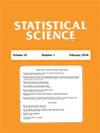A Probabilistic View on Predictive Constructions for Bayesian Learning
IF 3.9
1区 数学
Q1 STATISTICS & PROBABILITY
引用次数: 0
Abstract
Given a sequence $X=(X_1,X_2,\ldots)$ of random observations, a Bayesian forecaster aims to predict $X_{n+1}$ based on $(X_1,\ldots,X_n)$ for each $n\ge 0$. To this end, in principle, she only needs to select a collection $\sigma=(\sigma_0,\sigma_1,\ldots)$, called ``strategy"in what follows, where $\sigma_0(\cdot)=P(X_1\in\cdot)$ is the marginal distribution of $X_1$ and $\sigma_n(\cdot)=P(X_{n+1}\in\cdot\mid X_1,\ldots,X_n)$ the $n$-th predictive distribution. Because of the Ionescu-Tulcea theorem, $\sigma$ can be assigned directly, without passing through the usual prior/posterior scheme. One main advantage is that no prior probability is to be selected. In a nutshell, this is the predictive approach to Bayesian learning. A concise review of the latter is provided in this paper. We try to put such an approach in the right framework, to make clear a few misunderstandings, and to provide a unifying view. Some recent results are discussed as well. In addition, some new strategies are introduced and the corresponding distribution of the data sequence $X$ is determined. The strategies concern generalized P\'olya urns, random change points, covariates and stationary sequences.贝叶斯学习预测结构的概率观
给定一个随机观察序列$X=(X_1,X_2,\ldots)$,贝叶斯预测者的目标是基于$(X_1,\ldots,X_n)$对每个$n\ge 0$进行预测$X_{n+1}$。为此,原则上,她只需要选择一个集合$\sigma=(\sigma_0,\sigma_1,\ldots)$,下面称之为“策略”,其中$\sigma_0(\cdot)=P(X_1\in\cdot)$是$X_1$的边际分布,$\sigma_n(\cdot)=P(X_{n+1}\in\cdot\mid X_1,\ldots,X_n)$是$n$的预测分布。由于Ionescu-Tulcea定理,$\sigma$可以直接分配,而无需通过通常的先验/后验方案。一个主要的优点是不需要选择先验概率。简而言之,这就是贝叶斯学习的预测方法。本文对后者作了简要的综述。我们试图将这种方法置于正确的框架中,澄清一些误解,并提供一个统一的观点。本文还讨论了最近的一些研究结果。此外,还引入了一些新的策略,并确定了相应的数据序列$X$的分布。这些策略涉及到广义Pólya回合、随机变化点、协变量和平稳序列。
本文章由计算机程序翻译,如有差异,请以英文原文为准。
求助全文
约1分钟内获得全文
求助全文
来源期刊

Statistical Science
数学-统计学与概率论
CiteScore
6.50
自引率
1.80%
发文量
40
审稿时长
>12 weeks
期刊介绍:
The central purpose of Statistical Science is to convey the richness, breadth and unity of the field by presenting the full range of contemporary statistical thought at a moderate technical level, accessible to the wide community of practitioners, researchers and students of statistics and probability.
 求助内容:
求助内容: 应助结果提醒方式:
应助结果提醒方式:


